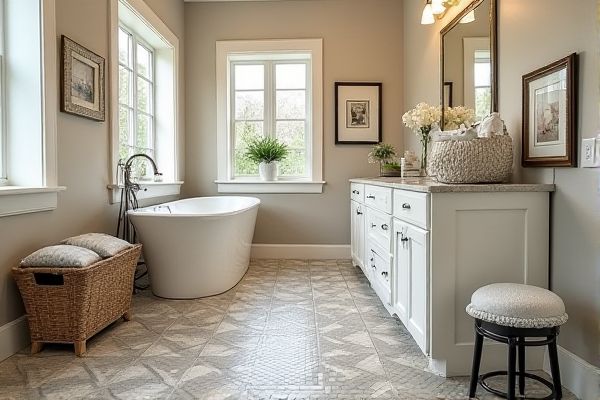
Mosaic accent tiles provide intricate patterns and vibrant colors that enhance focal areas, while border tiles frame and define spaces with clean, consistent lines for a polished look. Explore the rest of this article to discover how you can effectively use both to elevate your design.
Table of Comparison
| Feature | Mosaic Accent Tile | Border Tile |
|---|---|---|
| Design | Small, varied pieces forming intricate patterns or images | Thin, elongated strips designed to frame or edge surfaces |
| Purpose | Decorative focal point, adds texture and color | Defines edges, creates separation or transitions |
| Material | Glass, ceramic, stone, or metal | Ceramic, porcelain, natural stone |
| Installation Area | Feature walls, backsplashes, shower niches | Tile perimeters, borders in floors and walls |
| Size | Small individual pieces, usually under 2 inches | Narrow strips, length varies but typically longer than mosaics |
| Visual Impact | High visual interest, complex patterns | Subtle edge enhancement, clean lines |
| Cost | Generally higher due to intricate designs | Moderate, depends on material and length |
Understanding Mosaic Accent Tiles
Mosaic accent tiles consist of small, intricately arranged pieces that create detailed patterns or visual interest, often used to highlight specific areas in a space. Unlike border tiles, which are typically larger and designed to frame or define edges, mosaic accent tiles add texture and complexity through varied shapes, colors, and materials. Understanding the unique design and application of mosaic accent tiles enhances their use as focal points in kitchens, bathrooms, and accent walls.
What Are Border Tiles?
Border tiles are decorative tiles designed to frame or outline a tiled surface, creating a clean and distinct edge that enhances the overall design. Unlike mosaic accents, which often consist of small, intricate pieces arranged in patterns or images within a surface, border tiles typically form continuous lines or patterns that separate or highlight different sections of the tile layout. Understanding the role of border tiles can help you achieve a polished, professional look in your tiled spaces by defining boundaries and adding a cohesive finishing touch.
Key Differences Between Mosaic Accent and Border Tiles
Mosaic accent tiles consist of small, intricately arranged pieces that create detailed patterns or artistic designs, offering a decorative focal point in your space. Border tiles are typically larger, linear pieces designed to frame or outline an area, providing a clean, defined edge for walls, backsplashes, or floors. Choosing between mosaic accent and border tiles depends on whether you want to emphasize intricate visual interest or a structured boundary in your tile layout.
Aesthetic Impact: Mosaic Accents vs Border Tiles
Mosaic accents create intricate, eye-catching designs that serve as focal points, adding texture and vibrant color variations to your space. Border tiles provide a clean, structured frame that enhances room definition and complements overall decor without overwhelming the visual flow. Choosing between mosaic accents and border tiles depends on whether you want a dynamic, artistic statement or subtle, elegant outlining in your design.
Popular Design Applications for Mosaic Accent Tiles
Mosaic accent tiles, favored for their intricate patterns and vibrant colors, are widely used in kitchen backsplashes, bathroom walls, and shower niches to create visually striking focal points. Their small size and diverse material options, such as glass, ceramic, and natural stone, allow for versatile design applications that complement various interior styles. Unlike border tiles, mosaic accents provide rich texture and complexity, enhancing aesthetic appeal and making them ideal for artistic and detailed decorative elements.
Common Uses of Border Tiles in Interior Design
Border tiles are frequently used in interior design to create defined edges and frames around walls, floors, and backsplashes, enhancing visual structure and style. These tiles often highlight areas such as kitchen backsplashes, bathroom surrounds, and accent walls, bringing a polished, cohesive look to the space. You can use border tiles to complement mosaic accents, adding contrast while maintaining the overall design harmony.
Installation Considerations: Mosaic Accents vs Border Tiles
Mosaic accents require precise alignment and often smaller grout lines, making installation more labor-intensive compared to border tiles, which usually have larger, uniform shapes that simplify placement along edges. You should account for the intricate cutting and pattern planning needed for mosaic accents to maintain visual coherence, whereas border tiles offer straightforward installation with fewer adjustments. Proper substrate preparation and consistent adhesive application are crucial for both to ensure durability and aesthetic appeal.
Cost Comparison: Mosaic Accent vs Border Tile
Mosaic accent tiles typically cost more per square foot than border tiles due to their intricate designs and smaller individual pieces, which require more labor and precision during installation. Border tiles are generally larger, simpler, and easier to install, resulting in lower material and labor expenses. Homeowners should consider the budget impact of mosaic accents' higher pricing when planning decorative tile projects.
Maintenance and Durability Differences
Mosaic accents typically consist of smaller tiles made from glass, ceramic, or stone, offering high resistance to stains and water but requiring more frequent grout upkeep due to numerous joints. Border tiles are often larger and have fewer grout lines, resulting in easier cleaning and enhanced durability against chipping in high-traffic areas. Both options are durable, but masonry grout maintenance is more demanding for mosaic accents, while border tiles offer a robust, low-maintenance solution.
Choosing the Right Tile Style for Your Space
Mosaic accents offer intricate patterns and vibrant colors that create focal points and enhance visual interest in your space, while border tiles define edges with clean lines and add structure to your design. Your choice depends on whether you want to emphasize decorative detail or a polished frame that complements the overall aesthetic. Consider the room's size, lighting, and existing decor to select the tile style that best elevates your interior design.
 homyna.com
homyna.com